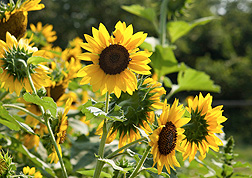Washington, DC, USA
January 27, 2014

Wild relatives of the genus Helianthus (sunflower) are abundant in U.S. gene banks, because sunflower is one of the few crops native to North America. Shown is a wild annual sunflower, H. annuus, one of 73 total species represented. Photo by Peggy Greb.
A first-of-its-kind inventory for wild and weedy relatives of important crops has been developed by U.S. Department of Agriculture (USDA) scientists and their collaborators.
According to Stephanie Greene, a plant geneticist with USDA's Agricultural Research Service (ARS), the inventory was created to aid the conservation of these so-called "crop wild relatives" (CWRs) and ensure their availability as prized sources of genetic diversity for an array of economically important traits, including improved drought tolerance and resistance to pests and diseases.
Greene and her colleagues prioritized the U.S. national inventory based on factors such as how closely related the wild species are to crops, especially those grown for food; their availability in gene banks or protected habitat areas, and the ease or difficulty of transferring desirable traits from the wild species to their cultivated "cousins."
All told, the inventory covers 4,596 taxa from 985 genera and 194 plant families that are either indigenous to the United States or have become naturalized—established of their own accord following human introduction. Among CWR of major crops, the genus Helianthus (sunflower) is the most abundant, numbering 73 total taxa, including H. annuus (domesticated as the sunflower). Other important CWRs include species closely related to strawberries, blackberries, raspberries, blueberries, grapes, and stone fruits such as cherries and plums.
There are many examples of native wild U.S. species that have played key roles in ensuring the continued health and productivity of crops grown worldwide, according to Greene, who works at the ARS Plant Germplasm Introduction and Testing Research Unit worksite in Prosser, Wash. The inventory itself lists 17 major crops that have benefitted from traits associated with 55 native CWR.
A recent example is cultivated sunflowers worldwide, which have benefitted from wild North American relatives in the form of resistance to rust, sclerotinia, downy mildew and other diseases and pests.
Read more about this research in the January 2014 issue of Agricultural Research magazine. ARS is USDA's principal intramural scientific research agency, and this work supports the USDA priority of promoting international food security.
Investigadores crean un inventario de los parientes silvestres de los cultivos agrícolas
El primer inventario de los parientes silvestres de los cultivos agrícolas importantes ha sido desarrollado por científicos del Servicio de Investigación Agrícola (ARS) y sus colaboradores.
Según Stephanie Greene, quien es genetista de plantas con el ARS, el inventario fue creado para facilitar la conservación de estos parientes silvestres de los cultivos (PSC) y para asegurar su disponibilidad como fuentes valoradas de diversidad genética para una gama amplia de rasgos económicamente importantes, incluyendo una mejor tolerancia a la sequía y resistencia a los insectos y las enfermedades.
Greene y sus colegas desarrollaron el inventario basado en factores tales como la intimidad de la relación entre la planta silvestre y el cultivo, especialmente en el caso de cultivos usados como una fuente de alimento; la disponibilidad de las especies silvestres en bancos de genes o en hábitats protegidos, y la facilidad o dificultad de transferir los rasgos deseados desde las especies silvestres hasta sus "primos" cultivados.
El inventario incluye 4.596 taxones de 985 géneros y 194 familias de plantas que son indígenas de EE.UU. o han llegan a ser naturalizadas en EE.UU.—es decir, establecidas por propia voluntad después de introducción por los seres humanos. Entre los PSC de los cultivos principales, el genero Helianthus es lo más abundante, con 73 taxones, incluyendo H. annuus (el girasol). Otros PSC importantes incluyen especies estrechamente relacionadas con la fresa, la zarzamora, la frambuesa, el arándano, la uva, y las frutas de hueso tales como la cereza y la ciruela.
Hay muchos ejemplos de especies nativas de EE.UU. que han tenido un papel imprescindible en asegurar la salud y la productividad continua de cultivos producidos mundialmente, según Greene, quien trabaja en el sitio de trabajo de la Unidad de Investigación y Introducción de Germoplasma de Plantas mantenida por el ARS en Prosser, Washington. El inventario incluye una lista de 17 cultivos principales que se han beneficiado de rasgos asociados con 55 PCS nativos.
Un ejemplo reciente es el girasol, el cual se cultiva mundialmente. El girasol se ha beneficiado de sus parientes silvestres en Norteamérica en forma de resistencia a la roya, el mildiú, y otras enfermedades y plagas.
Lea más sobre esta investigación en la revista 'Agricultural Research' de enero del 2014. ARS es la agencia principal de investigaciones científicas del Departamento de Agricultura de EE.UU. (USDA por sus siglas en inglés), y este trabajo apoya la prioridad del USDA de promover la seguridad alimentaria internacional.